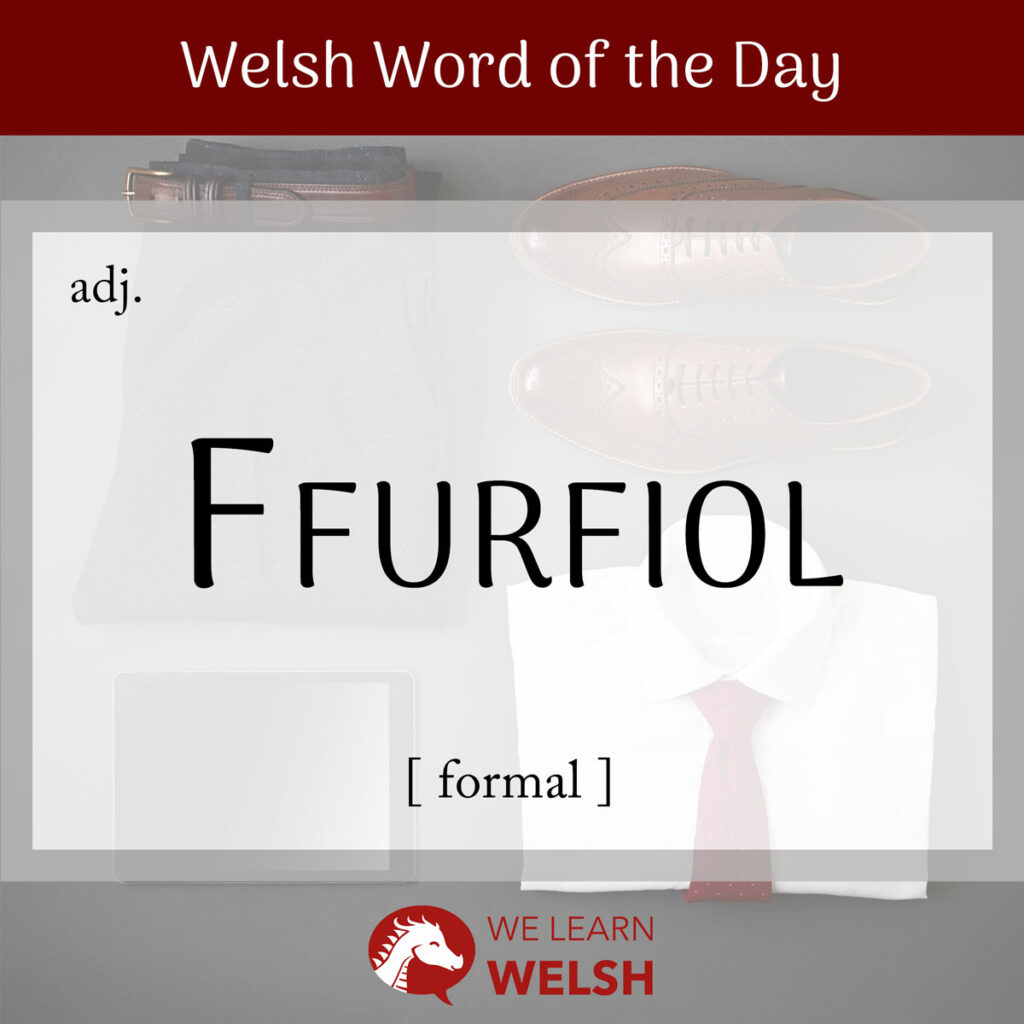As with most languages, the kind of Welsh you should use depends on the situation you’re in and who you’re talking to. A lot of this depends on how ffurfiol (formal) you need to be.
ffurfiol
formal
Ffurfiol is formed from the noun ffurf (form), combined with the suffix –iol, which is used a lot in Welsh to create adjectives from nouns. Other examples include gobeithiol (hopeful) from gobaith (hope) and gwreiddiol (original) from gwraidd (root). Ffurf itself was borrowed into proto-Brythonic from the Latin forma (form).
You can use the word ffurfiol whether the noun you’re describing is masculine, feminine, singular, or plural – it doesn’t change. In older Welsh, it might have become ffurfiolion when plural, but if you’re speaking to someone today, it would sound very odd (and possibly quite ffurfiol!) to pluralise it in this way.
Similarly, longer ago, ffurfiolaf would have been the go-to way to express the concept of most formal, but nowadays most people would just say mwyaf ffurfiol, with mwyaf meaning most. But a few related words that are still quite useful to know would be anffurfiol (informal), ffurfioli (to formalise), and ffurfioldeb / ffurfiolrwydd (formality).
Ff is not a letter that mutates in Welsh, which means you don’t have to learn any mutations for this word. Hwrê (hooray)!
The most important way of indicating how ffurfiol you want to be in Welsh is by choosing which word to use for you. The two main options are ti, which is used when speaking to one person you know well, and chi, which is used for speaking to a group, someone older than you, someone you don’t know well, or in a professional setting. It’s like tu and vous in French.
Mae’n gwmni ffurfiol iawn.
It’s a very formal company.
Over time, as societies evolve, they often become less ffurfiol in general, and the same is true for Welsh. In modern Wales, most people are more relaxed about using ti than they might have been fifty years ago. But if you want to err on the side of caution, chi is always a good option.
Another difference between ffurfiol (formal) and anffurfiol (informal) situations is the level of complexity and detail in the gramadeg (grammar) and geirfa (vocabulary) you’ll use.
There are two registers of Welsh as a language, llenyddol (literary) and llafar (colloquial). These aren’t exactly the same as ffurfiol and anffurfiol. Literary Welsh is more old-fashioned, and today only shows up in particularly poetic writing. Colloquial Welsh is equally correct and can be used in formal situations – even if you’re speaking to someone you don’t know well, using literary Welsh would sound quite strange.
However, there is a spectrum of iaith (language) in-between literary and colloquial. Sometimes you can use a grammatical expression that is a bit closer to the old-fashioned literary version to express formality. This might happen if you were writing a traethawd (essay), or you might see it in the newyddion (news).
(Mae) rhaid i ni aros am yr adolygiad ffurfiol.
We have to wait for the formal review.
Speaking of contexts in which more ffurfiol language is used – here are a few more!
- ysgol = school
- gwaith = work
- swyddfa = office
- eglwys / mosg / teml = church / mosque / temple
- llywodraeth = government
- banc = bank
- arholiad = exam
- llys = court
Of course, in most of these contexts, it’s not just enough to speak yn ffurfiol (formally). You’ll also need to wear gwisg ffurfiol (formal dress), which could include a siwt (suit) or an elegant ffrog (dress), and take particular care to be cwrtais (polite) and show parch (respect).
Figuring out how ffurfiol or anffurfiol you should be in any given situation is definitely one of the trickiest elements of social life. It’s hard enough in your first language, let alone your second! Rest assured that almost all Welsh people you speak to will just be grateful to get to chat in Welsh, and will correct you gently if you get something wrong.


